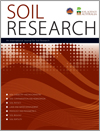Pastures contain a high amount of organic carbon and thus can play a critical role in climate change through both greenhouse gas emissions and carbon sequestration. However, the factors controlling organic carbon in those regions are largely unknown. Our findings showed that air temperature is likely the most influential factor on organic carbon stock and resistance time. Pastures, particularly in uplands, are sensitive to climate change, meaning pools stabilised for centuries to millennia are susceptible to alterations due to climate change.

Volume 62 Number 2 2024
Baseball infield soils should be tested to determine how soil water content influences their physical properties. We discovered that the angularity of the sand in an infield soil does not affect its performance, but that the distribution of sand sizes can affect the amount of clay needed to fill the pores between the sand grains. This research will help baseball field managers and scientists understand the behaviour of baseball infield soil mixtures.
We argue that the term ‘potential’ soil organic carbon (SOC) storage is not quantifiable using historical and current empirical data. We propose a framework that defines an upper limit of ‘attainable’ SOC that varies with soil properties, environmental conditions and applied management practices. We conclude that continuous update of the derived attainable deficit values will be required when new datasets covering different or new management practices capable of improving the capture of carbon to soil become available.
SR23096 Abstract | SR23096 Full Text | SR23096PDF (2.5 MB) | SR23096Supplementary Material (2.2 MB) Open Access Article
Creating maps at the farm-scale is a promising approach to for an accurate understanding of true spatial variation for a range of agronomically important soil attributes. This study assessed the value of different proximal and remote sensing datasets to map topsoil and subsoil carbon, clay content, and pH across three different farms in Australia. Results showed that using a combination of remote and proximal sensing data resulted in the best models, followed by remote only, and then proximal only.
SR23112 Abstract | SR23112 Full Text | SR23112PDF (1.9 MB) Open Access Article
There is growing interest in soil carbon as a climate mitigation strategy by the private and public sectors in Australia and globally. There is a scarcity of evidence in Australia for two of the key eligible management activities farmers can implement as part of the Australian soil carbon method for carbon sequestration. Farm-level data with credible evidence of soil carbon improvement at depth is lacking due to lack of long-term studies and shallow soil sampling.
SR23118 Abstract | SR23118 Full Text | SR23118PDF (838 KB) Open Access Article
Legacy datasets enable a preliminary study for soil security assessment to inform future research questions. In this study, we identified potential surrogates and the use of potential indicators for the assessment of soil to support a certain role. This work is important and enables the use of potential indicators when the surrogate is not available or difficult to obtain.
SR23138 Abstract | SR23138 Full Text | SR23138PDF (2.4 MB) Open Access Article
The use of no-till management practices is a key component to ensure food security and soil preservation. However, it may have disadvantages with respect to nitrogen use efficiency, including losses due to ammonia volatilisation. These losses trigger environmental, economic and human health problems. The study shows that under no-till, nitrogen losses can reach up to 62% with the use of urea. However, new nitrogen fertiliser technologies have reduced losses by more than 30% compared to urea, ensuring more sustainable agriculture.
Our short article reports an original dataset on soil solarisation from a grassland restoration project in Australia. Using this dataset, we demonstrate that sunlight may be a more influential driver of soil solarisation than previously thought. This result empowers land managers to better plan soil solarisation for restoration projects.
SR23168 Abstract | SR23168 Full Text | SR23168PDF (960 KB) | SR23168Supplementary Material (814 KB) Open Access Article
Bacillus subtilis, as a widely used microbial agent, could improve the damage caused by extensive application of fertiliser. We found that application of B. subtilis agent in moderation greatly improved soil fertility, promoted beneficial microbial communities, and regulated soil nitrogen cycling, while excessive dosage of B. subtilis might reduce the microbial diversity. The results could provide reference for cultivating crops with high demand for nitrogen fertiliser.




